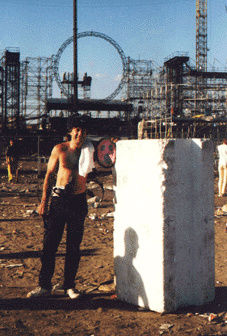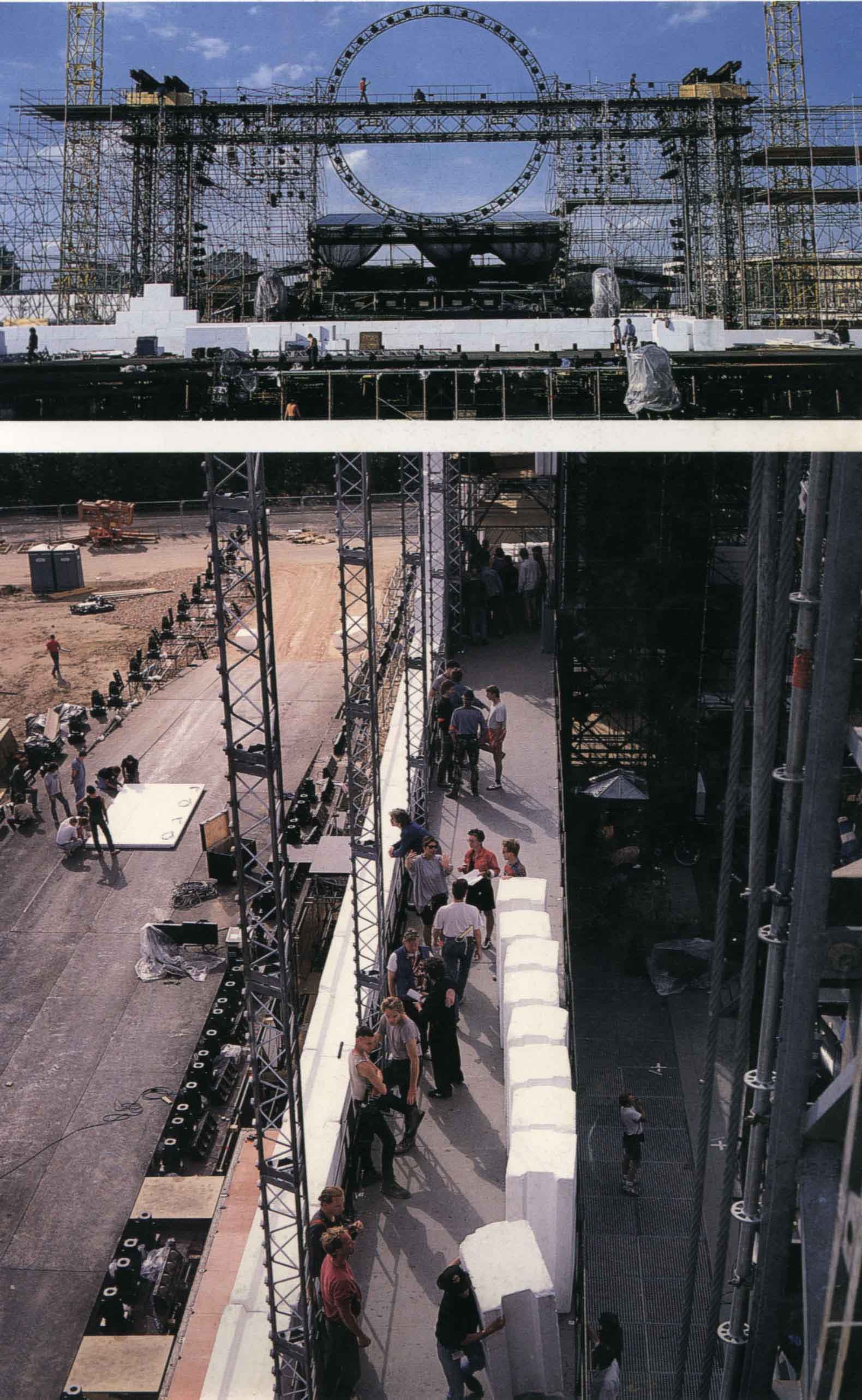Roger Waters performance of The Wall in Berlin in 1990 was held on vacant terrain between Potsdamer Platz and the Brandenburg Gate (a location which was part of the former "no-man's land" of the Berlin Wall) Negotiations started with the mayors of East Berlin and West Berlin for a one night performance on the Potzdamer Platz, the no mans land on the East Berlin side of the wall. East Berlin was in political and bureaucratic turmoil and nobody in government had any experience of staging rock shows. For five months there was great uncertainty about who should or even could give permission.

Negotiations started with the mayors of East Berlin and West Berlin for a one night performance on the Potzdamer Platz, the no mans land on the East Berlin side of the wall. East Berlin was in political and bureaucratic turmoil and nobody in government had any experience of staging rock shows. For five months there was great uncertainty about who should or even could give permission.
 |
The Backstage:
In front is a part of the Berlin Wall.
This concert was even bigger than the Pink Floyd era ones, as Waters built a 550-foot long and 82-foot high wall, which was broken down in the same show. On either side of the stage, built into the scaffolding supporting the brick storage, were two 50 meter- (164 foot) high tower cranes with 30 meter- (98 foot) jibs. A mobile telescopic crane was parked behind on stage left. The cranes were used to fly in sextons of the wall, support the Teacher puppet inflatable, and, in the second half, to raise a 40 meter- (131 foot) long lighting truss above the front of the wall. Instead of the puppet of the first wall, the Mother was now a Scarfe cartoon painted on the translucent covering of a light box.
|

 |
|
I talk with Jonathan Park about the constuction of the stage:
Ralf: The lifts for the wall builders had to also be increased in size and multiplied. You had decided to use scissors lifts, but instead built an entire 43 meter, 20 ton bridge. What were the lifting structures constructed of? Were there problems with these lifts as there had been before the original Wall shows?
Jonathan: Yes, when we looked into it, and the scissors lifts couldn't reach the height so, with my engineering back ground, I decided to use a long bridge lifted up at each end by cables running up over heavy duty scaffolding towers. All this equipment was ready made and adapted from steelwork centering used in the construction of Motorway flt-overs. Very convenient and totally adaptable. Surprisingly, it worked perfectly from the get go! The raising and lowering had to be precisely controlled and the bricklayers had to be especially careful not to get trapped getting on and off the bridge when it was moving up and down. Luckily, everything went smoothly, and it was the single most important element in allowing the Wall to be built and torn down - tear down the wall! - on cue.
Ralf: Why were the twenty five hundred 3 by 5 foot bricks used to construct the wall made of Polystyrene instead of the cardboard of the original Wall productions? Were there other options that were discussed?
|
Jonathan: The original bricks of Cardboard were made to fold up for easier travel on tour. Other materials would have been expensive and tricky to build up in the show with numbers and time scale! We had, for the original Wall show considered Styrene bricks, and thought they would be much more suitable here.
So when a German manufacturer offered to both make them and recycle them after the show, we jumped at the idea. They were an extruded shape with a slot at the top and a tongue underneath and nested together which made them really easy to build and take down (after the rehearsals). Also they were surprisingly light and indestructible!
 |
Ralf: Because of potential high wind speeds, you decided to use vertical masts and scaffolding as the structures used to keep the wall in place. What were some of the other options proposed?
Jonathan: We needed to find something that was virtually invisible to hold them up and we first thought of horizontal cables etc, but these wouldn't have allowed the Wall to be torn down. I then considered vertical masts, and one of the production managers, Chris Teuber, I think he is listed as the technical project manager, (I called him big foot because he was about size 12!) who worked on the original shows, came up with the bright idea of using the light lattice towers that he had seen all over Berlin which were used as hoists on all the building sites... so we had them ready made and they were absolutely right for the purpose of supporting the wall as it climbed up them! He was also responsible for the extremely simple and ingenious method of tying back the Wall brick to the masts... with a foot long baton attached to a yard of rope that was dropped into horizontal joints and quickly lashed back to the towers and trapped as the next course of brick was built. This held the wall up in any wind (I did proper structural calculations!), and just fell out when the Wall was torn down from the top at the climax of the show - simple and effective, eh!
Ralf: A massive amount of sound equipment was used including a PA consisting of 2 39 foot towers on the stage itself, a massive sound bank of speakers at stage front center, a large building in the middle of the crowd housing the mixing boards and lighting and special effects controls, and no less than 15 sound and light towers were located throughout Potsdam Platz. Yet many at the back and sides of the crowd still complained of poor sound quality. Was this because the huge size of the crowd, estimated between 350 to 700 thousand, was not anticipated?
|
Jonathan: Yes, but it also stretched the capability of the technology of the time. Also, I have to confess that someone forgot to switch them on at the start of the show, or there was a failure, and it took a long time to for the sound technicians to fight their way through the dense crowds out to 8 or 12 of the speaker towers!
|
The Wall had been created in only two-and-a-half months, with access to the Potzdamer Platz site for only the last four weeks. By normal rock show standards that was an impossibly tight schedule: Ideas and mechanisms, choreography, lighting, pyrotechnics, sound and logistics had all to be tested out and co-ordinated. The Setup "Impression" |
From what some may have termed a troubled beginning, The Wall carried on through to the end without a hitch. It was musically and theatrically a spectacle of sight and sound unequaled anywhere in the world EVER! No words can describe this event, no video can show the complexity, atmosphere or mesmerizing multimedia occurring simultaneously. No tape or recording can capture the stimulation of emotions this concert evoked. All that can be said is thank you Roger Waters for that once in a lifetime experience that I will never forget.